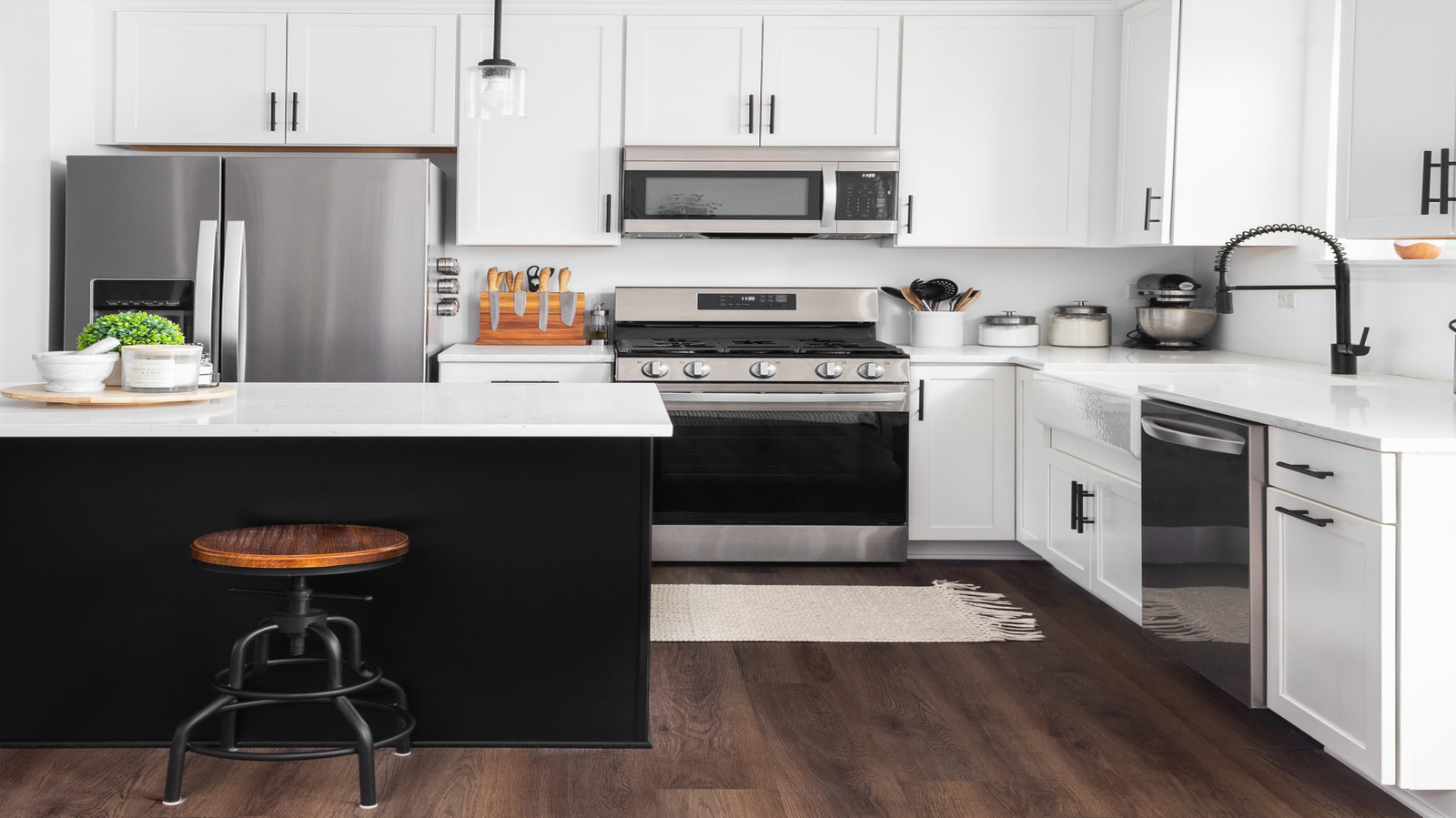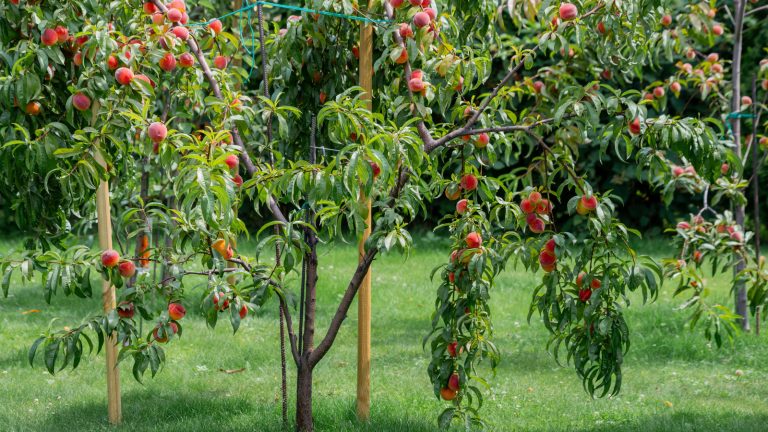
If you have a kitchen with cabinetry, chances are there are some large gaps between the tops of these cabinets and the bottom of the ceiling. What’s more, you might view this area as wasted space. Some older homes also contain soffits that connect to their kitchen cabinets along with empty spaces between cabinetry and the ceiling. While not functionally necessary in modern-day kitchens, open spaces above cabinets still remain in many houses, much to homeowners’ chagrin.
Aside from kitchen cabinet ideas and inspiration, you may be wanting to cover up those empty spots. The good news is you don’t have to put up with those wasted spaces in your kitchen any longer. Whether you want to add some visual design elements, extend your cabinetry, or perhaps use the area for storage, the creative possibilities for filling the empty spaces above your cabinets are endless. Instead of letting this space be, consider the multiple ways you can utilize them as either functional or design purposes. (As a bonus, your goals can include both!)
Store baskets and decorative storage boxes with style
One way you can fill in the empty spaces on top of your kitchen cabinets is to add decorative baskets or boxes. As a bonus, these pieces may even be used to store smaller items out of sight, such as cooking spices, candles, towels, napkin rings, and any other dining accessories that don’t currently have designated homes. This method focuses on maximizing as much space as you can in the kitchen without deterring from the overall design of the space.
If you’re using this method as more of a storage idea, some designers recommend choosing bins or baskets to match your cabinets as closely as possible. This will create a more seamless visual, and the storage aspect won’t be so obvious. Another option is to use decorative open boxes for storing random items that might otherwise be in a kitchen junk drawer. If you choose to label baskets and boxes to heighten your organizational efforts, consider using stylish text or artistic notecards so you don’t risk making the space look like a storage closet.
Add plants and greenery to your kitchen
Earthy tones have been trending in home kitchens for the last several years, and softer green hues are among them. You can take part in this trend without changing the color of any items in your kitchen, and with the added benefit of filling above-cabinet spaces. This can be accomplished by adding houseplants and other pieces of greenery to your kitchen. As a bonus, having more plants in your home can purify the air and even increase your overall sense of well-being.
Before adding any plants to the spaces above your cabinets, it’s important to steer clear of those that require a lot of direct sunlight. As such, consider more low-maintenance options such as spider plants, snake plants, aloe vera, and Chinese evergreen. Alternatively, if plant caring isn’t your strong suit, you might consider artificial plants instead. Just be sure that if you do add fake plants in the home that you dust them regularly to keep both your kitchen and air quality in clean order.
Use the cabinets as spaces for seasonal decor
While you can certainly add accents to the spaces above your kitchen cabinets, you’re also not limited to having the same decor all year-round. Instead, you can use this as an opportunity to showcase seasonal decorations. You may do so in addition to other decor you have around the house, but using cabinets for this purpose can be even more valuable if you are short on space and do not normally have an opportunity to decorate seasonally. In many cases, you only have to swap out a few pieces of decor to transform the space into something that reflects the season.
If you’re interested in decorating the tops of your cabinets seasonally and don’t know where to start, consider some colors and symbols commonly associated with each of the four seasons. For example, flowers, birds, herbs, and pastels work well for spring, while blue, white, and nautical themes evoke more summer vibes. Pumpkins, apples, and warmer earthy tones are great for autumn, as well as rustic accent pieces. Finally, winter decor can consist of evergreens, or anything festive and cozy. You can even add some extra strands of lights above the cabinets to help make the kitchen merry and bright. Another option is to swap out your decor more often to honor any holidays you celebrate throughout the year, such as Christmas decor ideas and inspiration.
Display your favorite platters and specialty plates
Chances are, you may have some seasonal plates and platters that can double as decorative items during certain times of the year. Displaying these above your cabinets with other seasonal decor is one possibility, but you’re also not limited to holiday plates only. With a few pieces of hardware, you can display your favorite platters, fine china, and other specialty plates to help distract from the otherwise empty feeling the space above your kitchen cabinet emits. This idea is especially beneficial if you don’t currently have space for a china cabinet or if you’re simply out of room for plates altogether.
Whether you want to display your plates by color, pattern, or theme, you have a few different options for doing so. The first involves hanging these items directly onto the wall above the cabinets. Another less permanent solution is to display them on plate holders and let them directly sit on top of your cabinetry. In fact, the latter method might be more practical if you need to take the plates down and use them on occasion; just be sure you wash them before placing any food onto them.
Add books and decorative bookends
Options for filling in the space above your cabinets aren’t exclusive to extra kitchen items, decorations, and plants. In fact, you can use this as an opportunity to store books. This option particularly works well for cookbooks and recipe collections. However, the books do not have to necessarily be cooking-related. If you have piles of books, or just limited space for a home library more generally, you can store them in this area while showcasing your love for reading all at the same time.
There’s really no right or wrong way to place books on top of your cabinets, but you do have some options to consider. For example, you can arrange your books by color, or perhaps in alphabetical order by title or author. If you have multiple genres of books, another option is to display them by category. Some people also prefer to place hardcover books and paperbacks in separate spaces with others of similar binding. Yet another option is to organize your books by height to give a more seamless appearance. A final consideration is to organize your books similar to the way you would on a bookshelf, so that all your best reads are always front and center. No matter which organizational method you choose, consider topping off it all off with some decorative bookends to keep your books in place with an extra bit of style.
Place framed artwork and photographs above your cabinets
Framed artwork and family photos are often seen gracing the walls of living rooms, home offices, and on bookcases. If you are particularly fond of framed works, you can take advantage of the spaces above cabinets as yet another option to display them. When using this idea, know that your options aren’t limited to traditional photographs and artwork. You can also place other kitchen-related items into display frames, such as handwritten family recipes, a picture of a meal, or even a paper menu from a favorite restaurant.
There are two ways to use frames above your cabinet. First, you can hang them directly on the wall, which can work especially well if you don’t plan on changing them out any time in the near future. You can also use frames with stands and place them directly on top of the cabinets. When using the second method, just be sure to choose steady frames, and take care not to shut any of the cabinet doors too heavy-handedly so they don’t fall over. Also, before placing any treasured artwork and photos above your cabinets, it’s important they are placed in completely sealed frames to prevent damage from everyday cooking byproducts, such as steam.
Showcase souvenirs and mementos
Chances are that you have some family or personal mementos trapped in boxes or bins because you don’t know where to put them. And, if you travel, you may even have some souvenirs you knew you just had to buy during your trip, only to be at a loss of where to place them once you got back home. Instead of placing these types of keepsakes in a bookcase or on a dusty shelf, consider doing something unique to showcase these items. With a bit of planning and intention, these can all work well on top of your kitchen cabinets.
There are a few ways you can go about displaying souvenirs and mementos on top of your kitchen cabinets. First, you can organize them by color or theme, or perhaps create more contrast with varying sizes and accent pieces. Another option is to have a theme on top of each cabinet, such as items from a single trip or phase of your life. You can also create shadowboxes to store smaller items for a more stylish (and less dusty) display option. Examples include tickets, receipts, postcards, and other collage-like items that would otherwise be left to sit in a drawer.
Extend existing cabinetry to the ceiling
If you have a larger budget and are craving more enclosed storage space, you might consider filling empty spaces below your ceiling with even more cabinets. This can be a viable option to make the area above the existing kitchen cabinetry more functional to suit you and your family’s needs. This option will particularly work well for storing away items you use only on an occasional basis, such as holiday platters, larger pots, and seasonal decorative items. Not only will extending cabinets to the ceiling give you more storage, but it will also make the kitchen appear more balanced overall.
Before you install more cabinets on top of existing kitchen cabinetry, there are few caveats to consider. First, know that this may be the least budget-friendly way to fill in the spaces above your cabinets because of the costs associated with the materials and possible professional installation if you choose not to install kitchen cabinets yourself. The process may become even more expensive if you decide to replace all of the cabinets with taller versions that go up to the ceiling. As a general rule of thumb, taller cabinets are costlier than standard versions. Another important caveat is accessibility: you will also need to consider adding a safety ladder or step stool to help you reach these cabinets.
Paint the wall above the cabinets
If you want a relatively quick solution to filling in the space above your cabinets, consider giving this part of the wall a fresh coat of paint. Not only will this make the area appear less noticeable, but it’s also an opportunity to either go bold or to make your kitchen look a bit more balanced overall. Painting may also arguably the most budget-friendly way to distract from the empty space above your cabinets. All you need is paint, some supplies, and a few hours to get the job done.
The exact color choice depends on what you’re hoping to achieve with this empty spot in your kitchen. For example, you can paint the area above your cabinets and underneath the ceiling a color that matches your cabinets or kitchen backsplash, or you can splash on a brighter hue that complements other elements in the space. In fact, adding a pop of color can give new vibes to a kitchen that may be more muted or dated.
Yet another option is to paint the area the same color as your ceiling, which may also work best if you have high ceilings and want the space to look cozier. Aside from the best types of paint to use in a kitchen, you should also plan your color accordingly. As a rule of thumb, designers tend to recommend gray, earthy blues and greens, or even classic white hues for smaller kitchens to create a more timeless and less distracted aesthetic.






